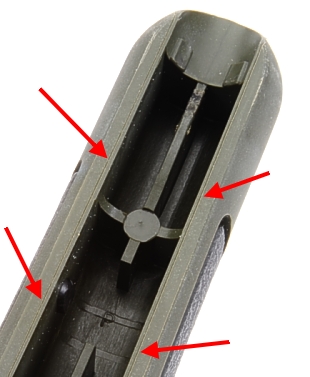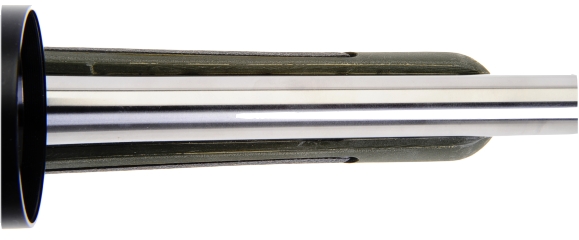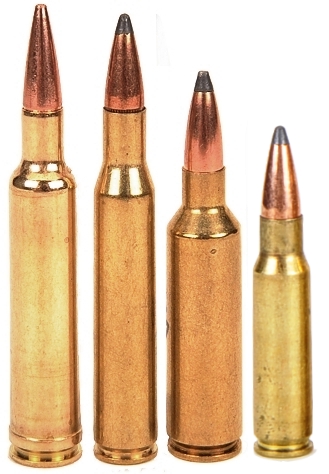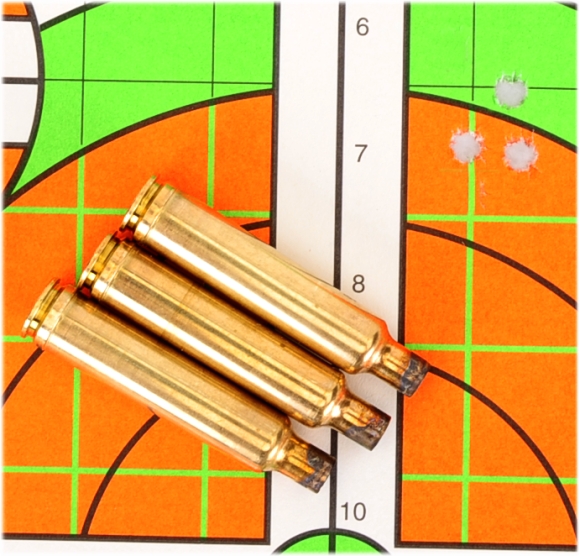When the barreled action was completed and finish chambered in “Either a 338 Ultra Mag… or a Nifty Paperweight Part 6“. The intention was to make some decisions regarding final finish and stocking, but that will take some time and I wanted to shoot the rifle as soon as possible. As a firearm enthusiast, there is nothing better than making something go boom, in a safe and correct way, and making a number of non-working things into at least one working thing.
On the bench was the newly barreled action, behind the lathe were the remnants of a past experiment with H414 and a remotely triggered Remington Model 700 XCR II 30-06 Springfield which led to its bolt becoming pretty much at one with its barrel. No, I am not a hoarder, but thank you for asking. I like to think of these types of sidelined firearms is as part of a pool that is ripe for cannibalization.
I learned about cannibalizing as a B-52 crew chief on SEA Arc Light rotation. Stay out on the flight line for a day or two straight, inspect and repair your aircraft to get it ready for the next “ball game”. Leave it attended by only a patrolling AP for fifteen minutes while making a parts run, and return to find a plane missing three engines, a hydraulic pack, an inboard flap, and a bomb door panel. Parts belonged to those who needed them, left a proper entry in the aircraft forms… and didn’t get caught. Not that I’d ever do such a thing. What made me write this passage? Old people get ADHD like children and telling irrelevant and repetitive stories is a way to regain focus.
 The stock and bottom metal were taken from the Remington Model 700 XCR II, however, the recoil lug on the new magnum action was thicker which located the trigger guard fastener holes a half diameter forward. In addition, the new action’s Remington #2 profile required rework of the more slender 30-06 Springfield barrel channel.
The stock and bottom metal were taken from the Remington Model 700 XCR II, however, the recoil lug on the new magnum action was thicker which located the trigger guard fastener holes a half diameter forward. In addition, the new action’s Remington #2 profile required rework of the more slender 30-06 Springfield barrel channel.
| Barrel | Diameter “ At Receiver |
Diameter “ End of Taper |
Diameter “ Mid Point |
Diameter “ Muzzle |
Barrel Length “ |
| 30-06 | 1.180 | 0.775 | 0.680 | 0.660 | 22 |
| 270 WM | 1.250 | 0.865 | 0.750 | 0.680 | 26 |
Modifications
A Dremel with rotary file guided with a block of Nylon 66 makes for straight or at least neat cuts

Adjusting for recoil lug placement was the first step, because shifting the action and barrel changes where the barrel taper falls in the barrel channel. Part of the cross rib was removed and the remaining was thinned. The large remaining reinforcement block takes the hit, but seems large enough to take the beating for this prototyping phase of the project.
Some very specialize tools were required to accomplish snug inletting that may not be found is an amateur’s shop. The barreled action was lowered into the stock and eye balled level in the barrel channel. Then a box cutter with blade sides taped was run down the sides of the barrel to transfer the profile to the top of the stock.

With the stock in a maintenance cradle, I went at it with about $20 worth of files, removing a very little at a time until the barrel drop in with a minimal gap. The speed bumps are the forend were removed to level the barrel. When I open up channels for heavy barrels with slight or no taper, I just cut a piece of aluminum tubing of appropriate diameter, wind wrap it with abrasive shop roll and shape the entire channel with each stroke.

The rifle went together in a tight assembly, a Bushnell 4.5-30x50mm scope was mounted and boresighted and I went looking for some ammunition.
The 270 Line Up
 There are not many 0.277″ bullet production cartridges, while there have been many 0.277″ wildcat cartridge, but few that have caught on. Of all of the surviving WSM cartridges, the .270 WSM has impressed me the most. The 6.8 SPC has impressed me the very least. The factory 270 Winchester is a well balanced and flat shooting round. The 270 Weatherby is my favorite of all, probably because it is faster than the rest and it is rewarding to handload.
There are not many 0.277″ bullet production cartridges, while there have been many 0.277″ wildcat cartridge, but few that have caught on. Of all of the surviving WSM cartridges, the .270 WSM has impressed me the most. The 6.8 SPC has impressed me the very least. The factory 270 Winchester is a well balanced and flat shooting round. The 270 Weatherby is my favorite of all, probably because it is faster than the rest and it is rewarding to handload.
Performance wise, 150 grain bullets shot from 26″ barrels, 270 Winchester, 270 WSM, 270 Weatherby have muzzle velocities respectively of 2,850 fps, 3120 fps and 3300 fps. Weatherby factory ammunition is more costly and handloaders consume more powder, but those consequences mean little to the typical firearm enthusiast. But I am getting ahead of myself…
For the purpose of checkout, the project rifle only saw 130 grain 270 Weatherby factory ammunition. Weatherby rates this ammunition at 3,400 fps. Over a calibrated chronograph, the project rifle consistently delivered 3,460 fps to 3,473 fps, first 5 shots through the new barrel. Everything worked like a champ, no signs of excess pressure, chambering and extraction were slick. Some tinkering is required to properly time magazine feed, although I was able to load three in the magazine with a little care and then cycle all without a problem.
Shots 6, 7 & 8 were used for the first 100 yard three shot group pictured below, 1/2″ center to center at the widest point. The next step is to push the target out to 200 yards and to log cartridge before and after firing dimensions and to inspect for any signs of case separation or chamber wall imprinting. That step will have to wait a bit, not too long, just long enough time to catch up on review backlog. Happy so far with the progress.


Email Notification